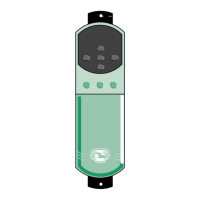Enclosure Guidelines
Heat Dissipation in a Sealed Enclosure
If possible, locate heat-generating equipment in the
lower part of the enclosure to encourage internal
convection. Otherwise, use a taller enclosure or install
stirrer fans.
The enclosure must be of adequate size to maintain
sufficient cooling of the drive when it is installed inside a
sealed enclosure. Heat generated by all the equipment
in the enclosure must be taken into account. To
calculate the minimum acceptable size of an enclosure,
use the following procedure:
Calculate the minimum required surface area Ae
for the enclosure from:
P
A
e
=
k(Ti - Tamb)
Where:
Tamb Maximum ambient temperature in °C
external to the enclosure.
Ae Unobstructed heat-conducting are in
mm
2
.
k Heat transmission coefficient of the
enclosure material.
Ti Maximum permissible operating
temperature in °C.
P Power in watts dissipated by all heat
sources in the enclosure.
Example:
To calculate the size of an enclosure for model
UNI 1403 (1.5kW, 2HP).
The following conditions are assumed:
The Drive is surface-mounted inside the
enclosure.
Only the top, front, and two sides of the
enclosure are free to dissipate heat.
The enclosure is made from painted 2mm
(.079in) sheet steel.
Maximum external air temperature: 30°C (86°F).
Insert the following values:
Ti = 40°C
Tamb = 30°C
k = 5.5 (typical for painted 2mm (.079in)
sheet steel)
P = 100 at 3kHz (see pages 18 &19)
Note:
It is essential to include any other heat sources in
the value of P.
The minimum required heat conducting area is
then:
100
A
e
=
5.5(40 - 30)
= 1.81m
2
Estimate two of the enclosure dimensions — the
height (H) and depth (D), for instance. Calculate the
width (W) from:
Ae - 2HD
W =
H + D
Inserting H = D = 0.5m, obtain the minimum
width:
1.81 - (2 x 0.5 x 0.5)
W =
0.5 + 0.5
= 0.81m
Heat Dissipation in a Ventilated Enclosure
If a high ingress protection rating is not required,
the enclosure may be smaller. A ventilating fan can be
used to exchange air between the inside and outside
of the enclosure.
To calculate the volume of ventilating air, use the
following equation:
3.1P
V =
Ti - Tamb
Where V = Air-flow in m
3
per hour.
Example:
P = 100
Ti = 40°C
Tamb = 30°C
Then:
3.1 x 73
V =
40 - 30
= 31m
3
/ hr
drive installation
23

